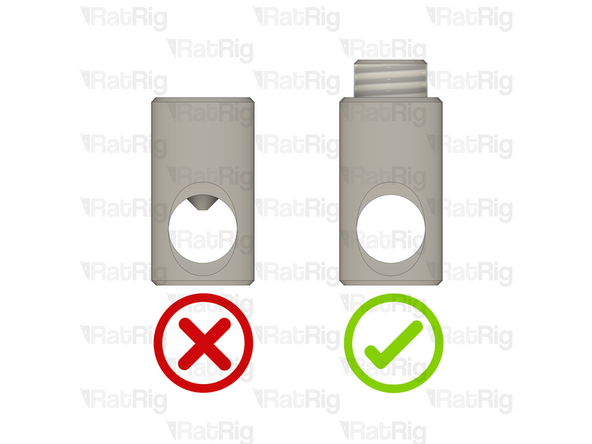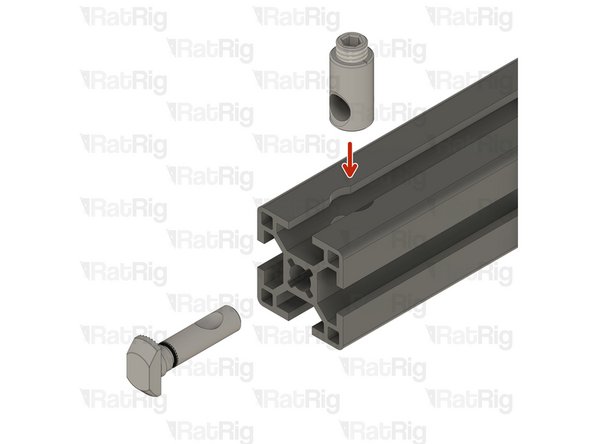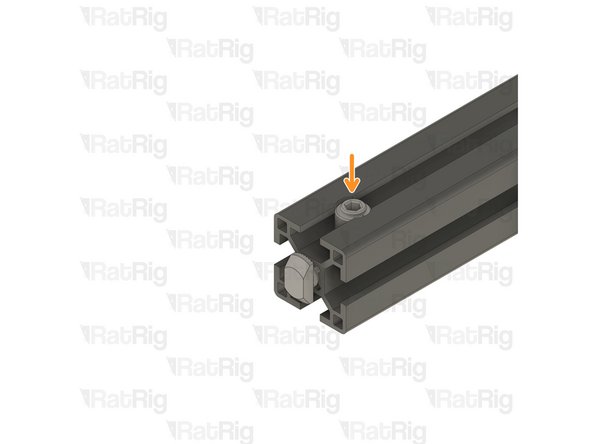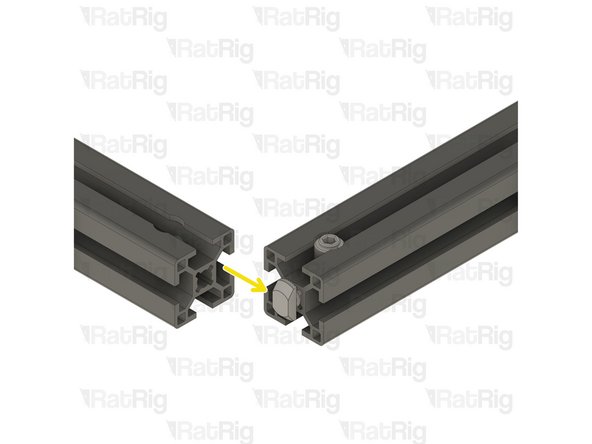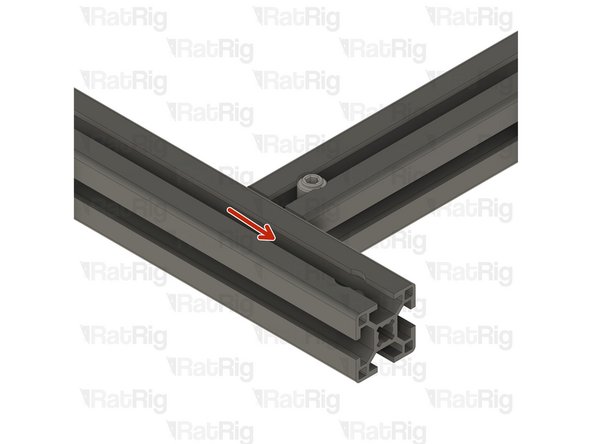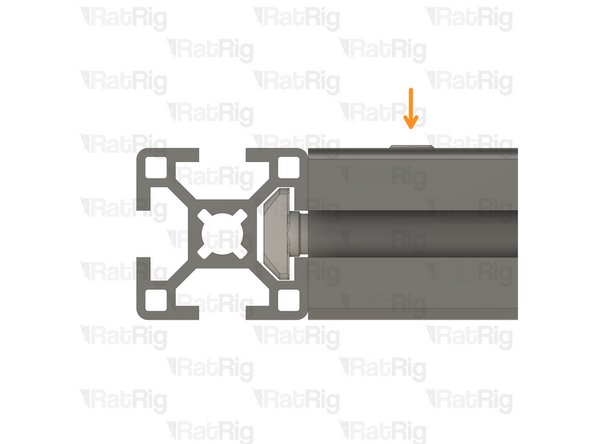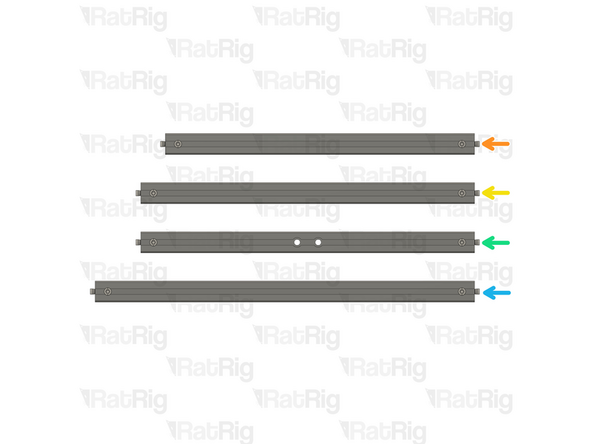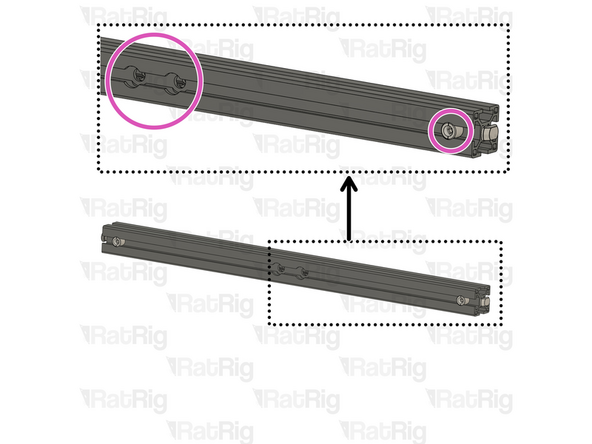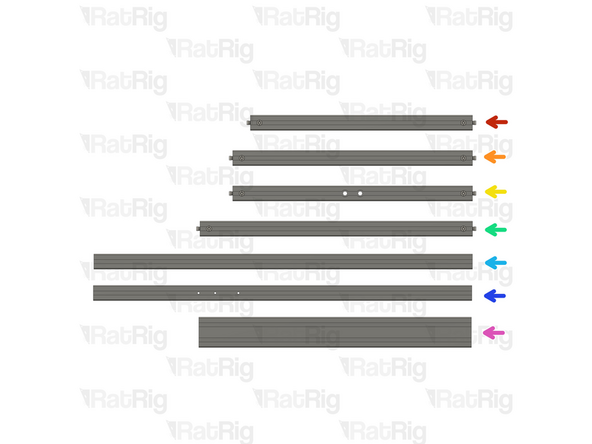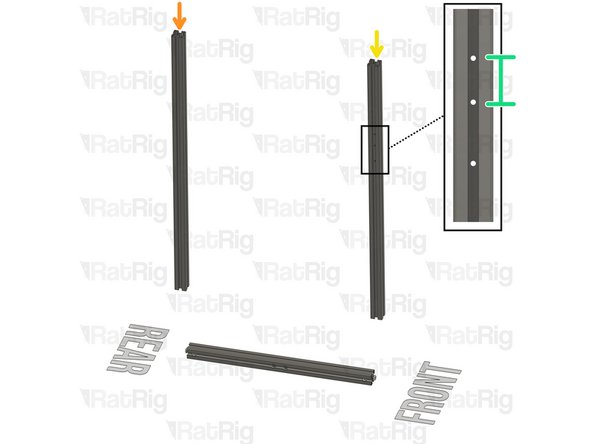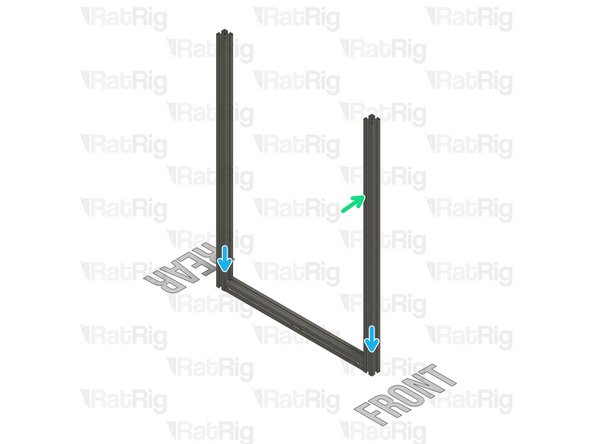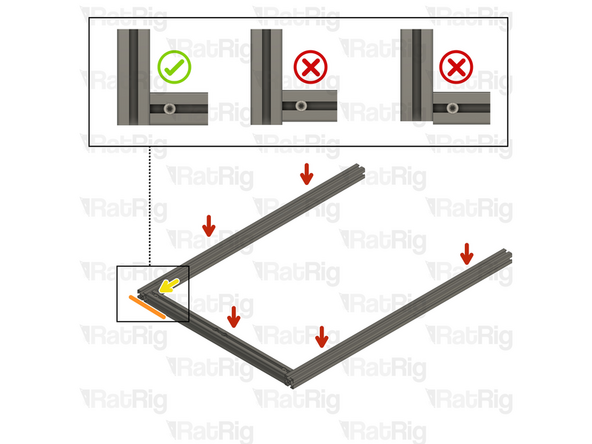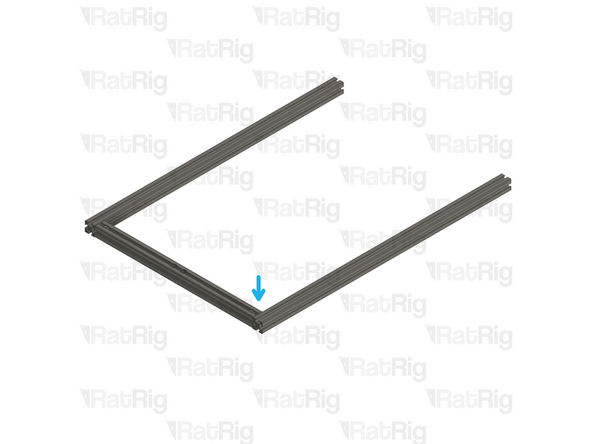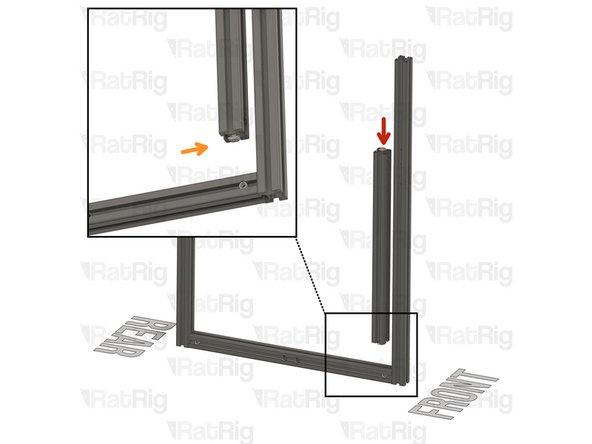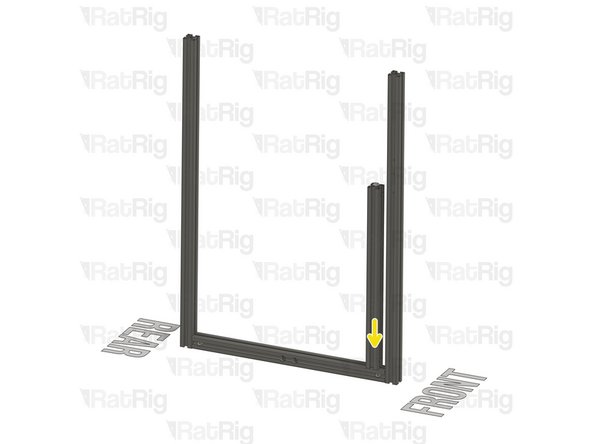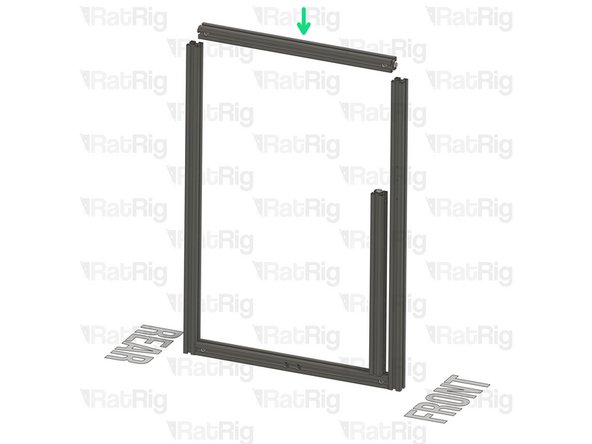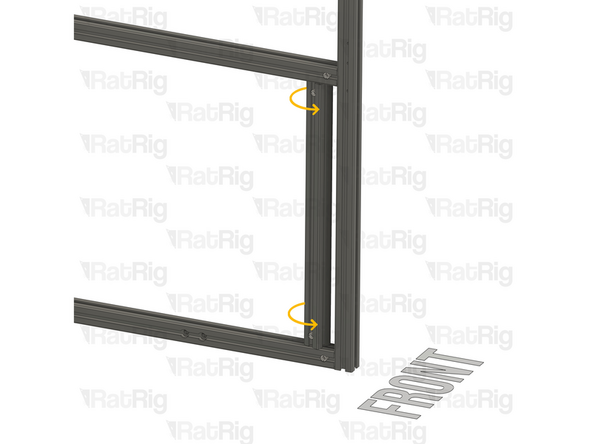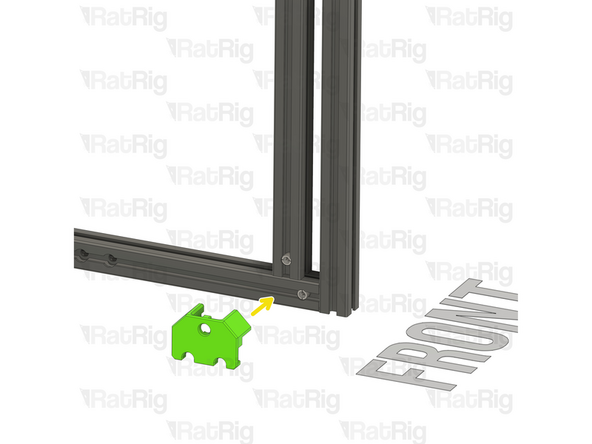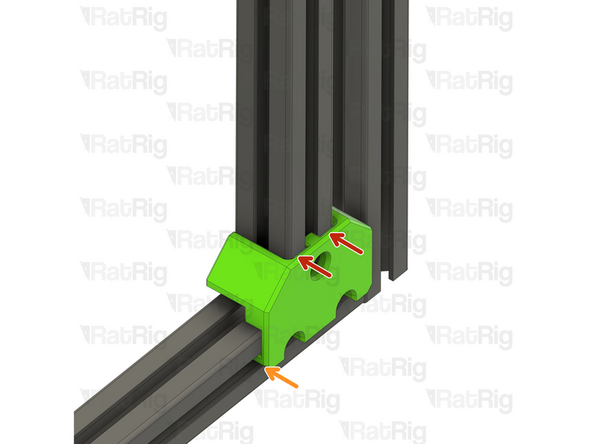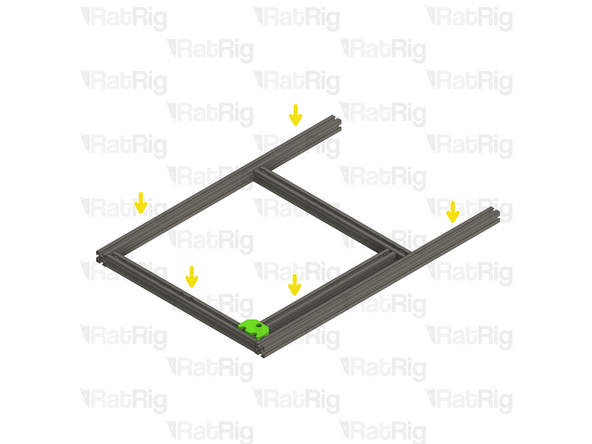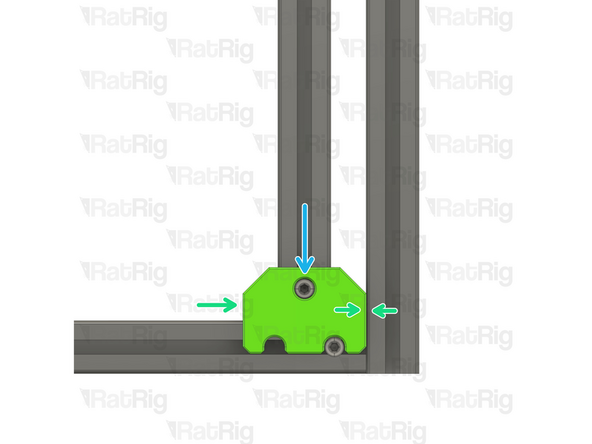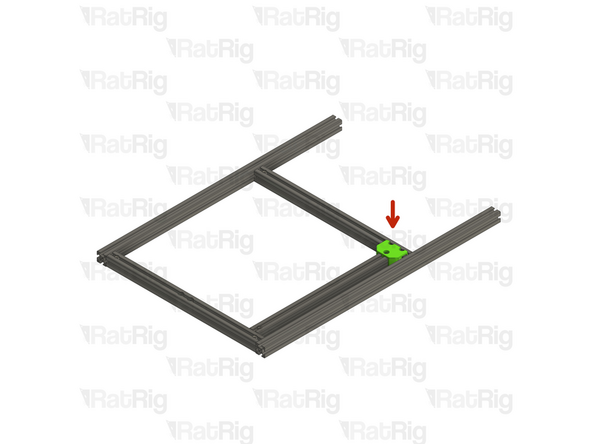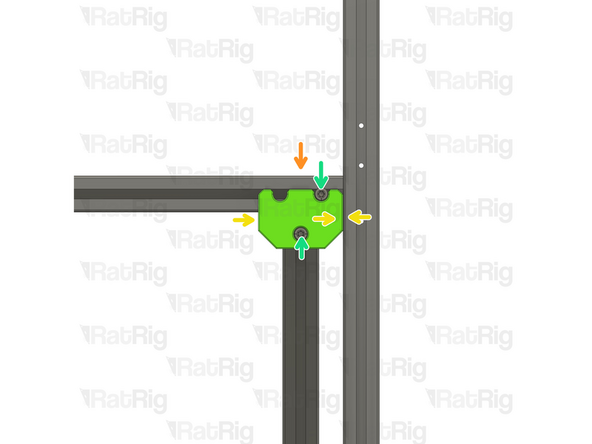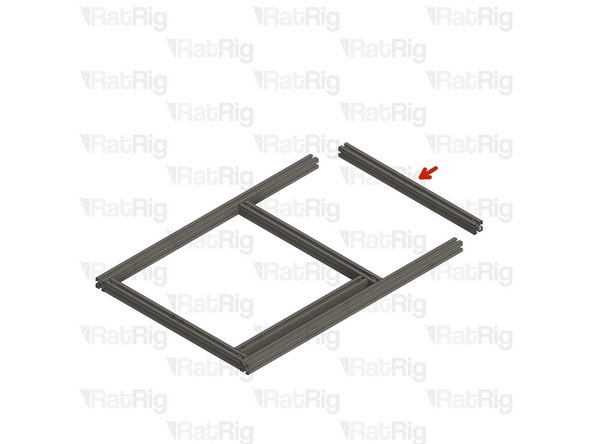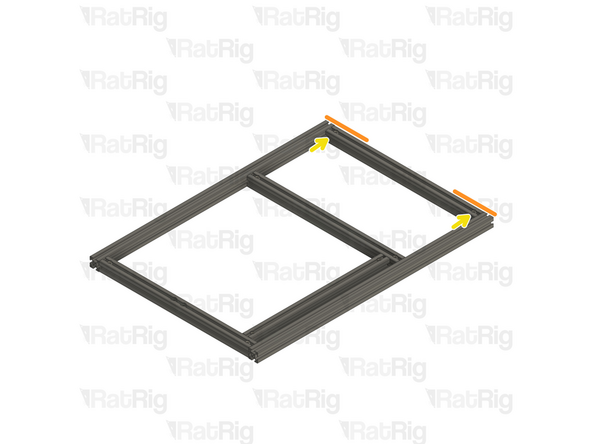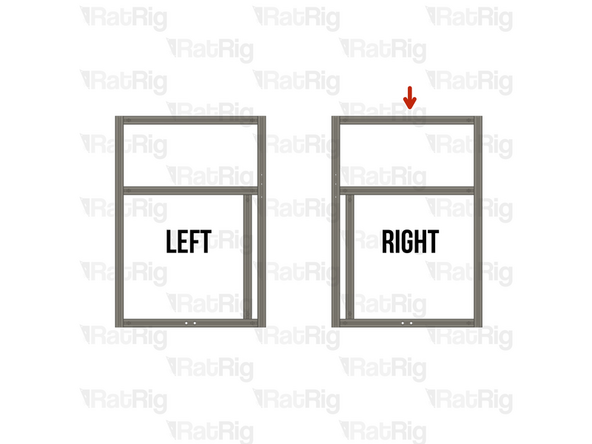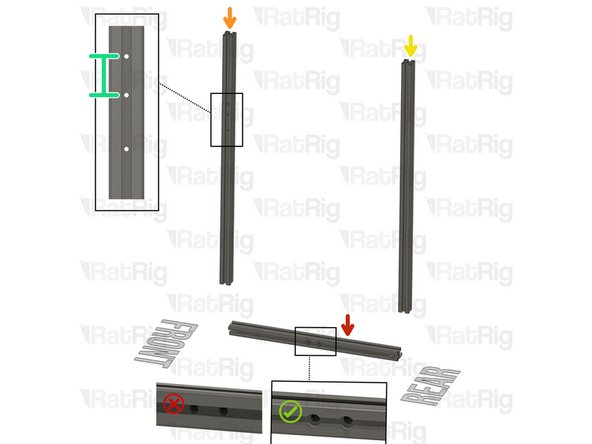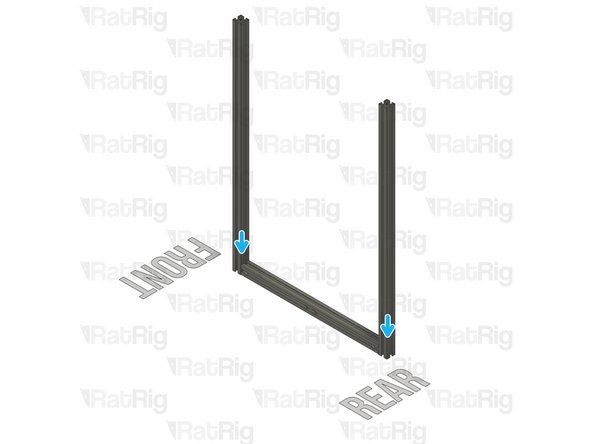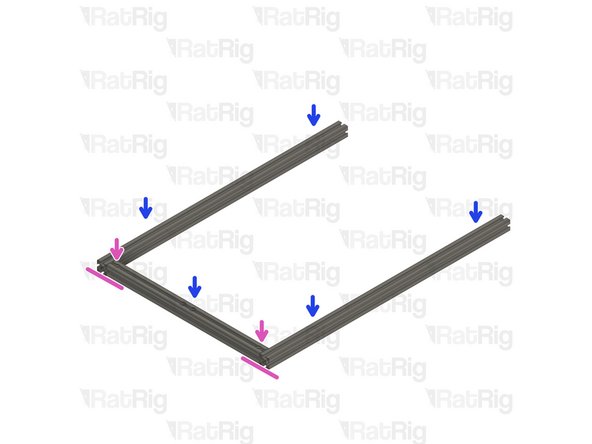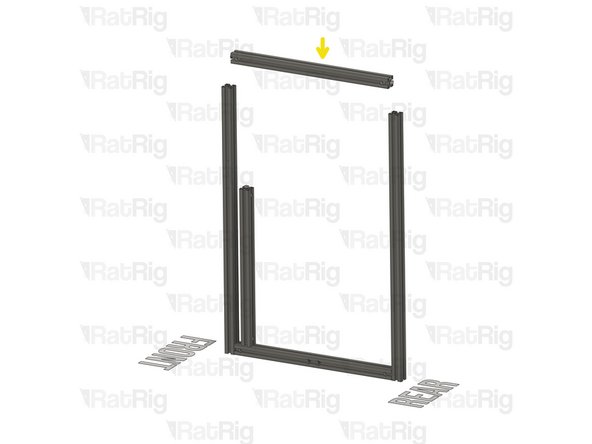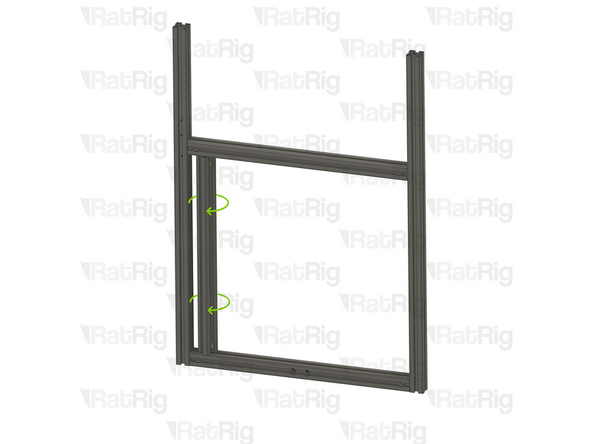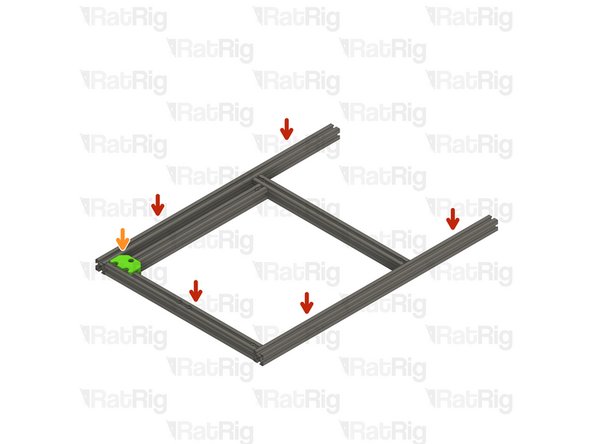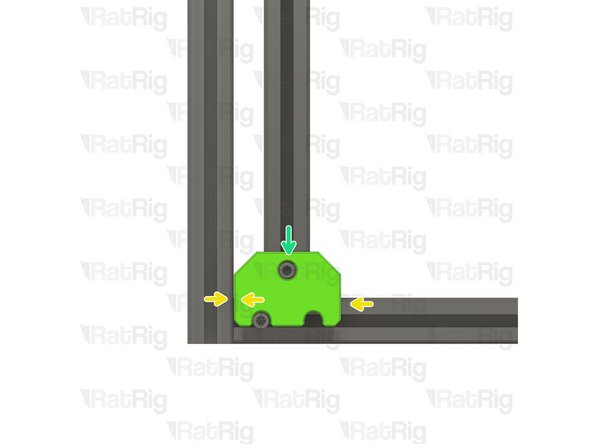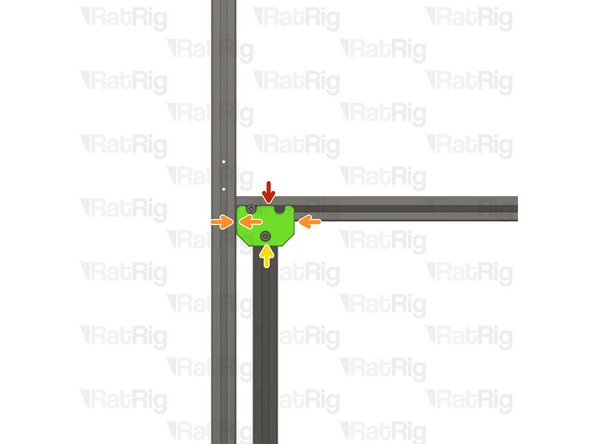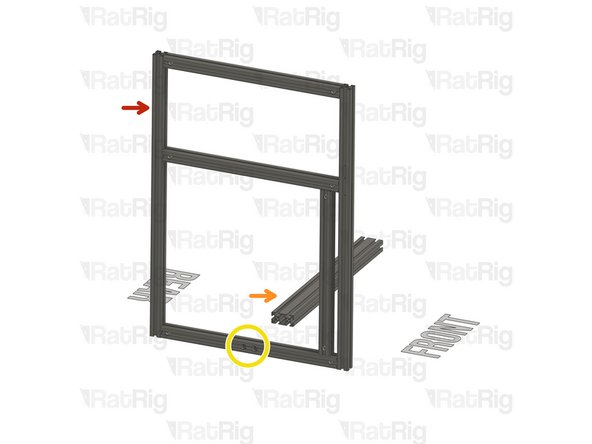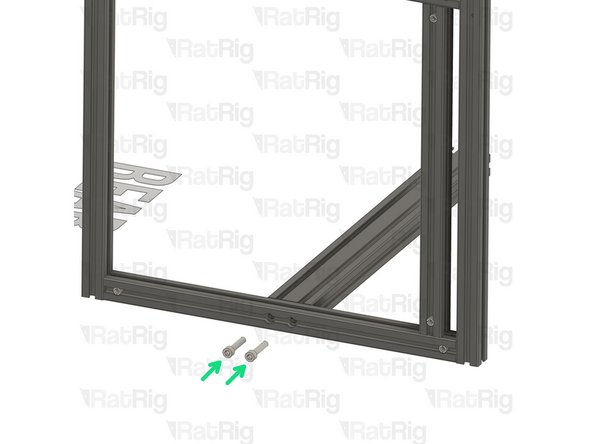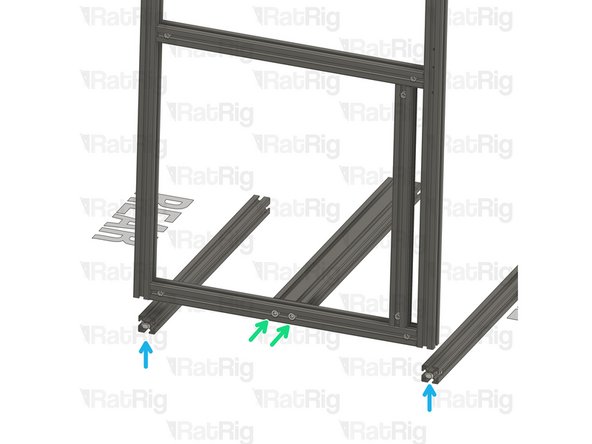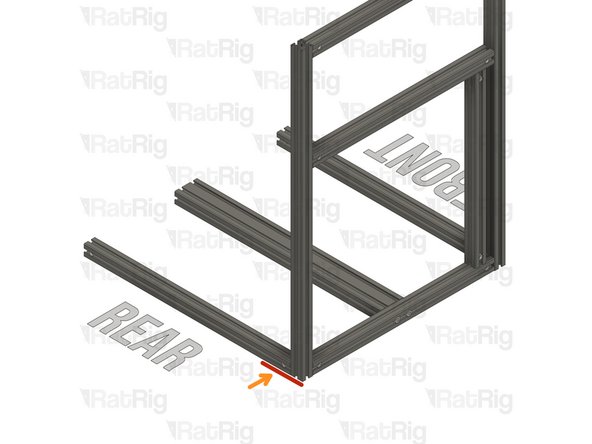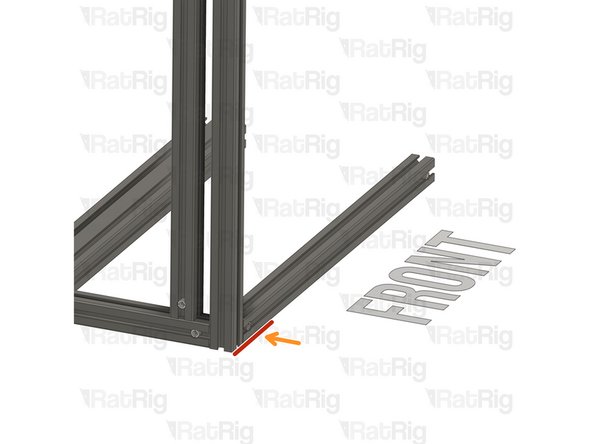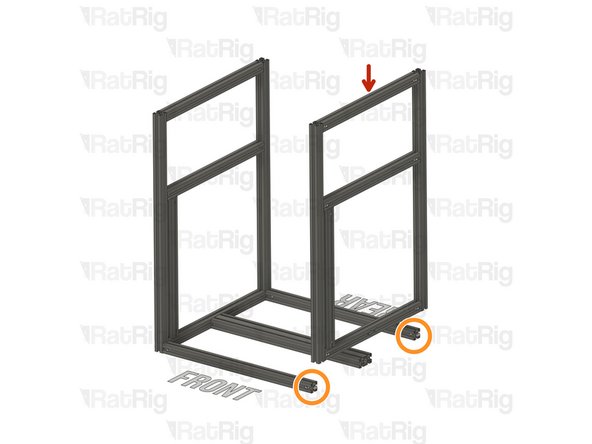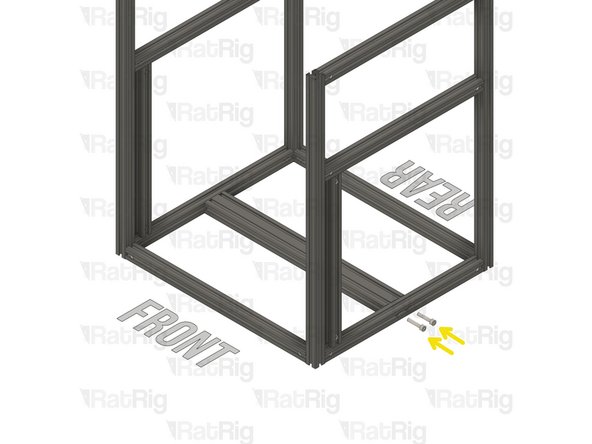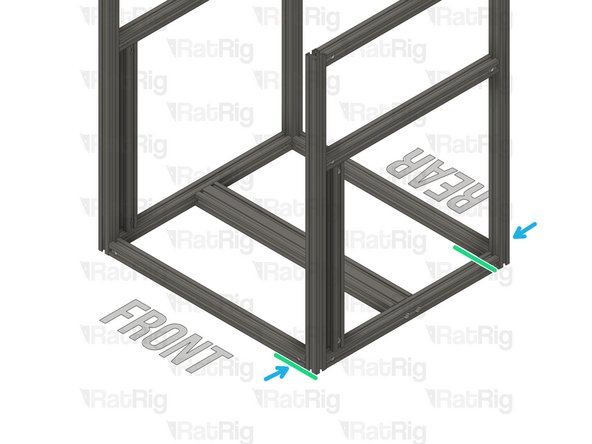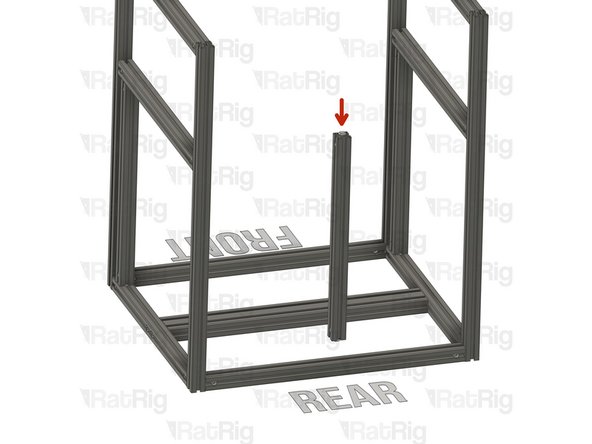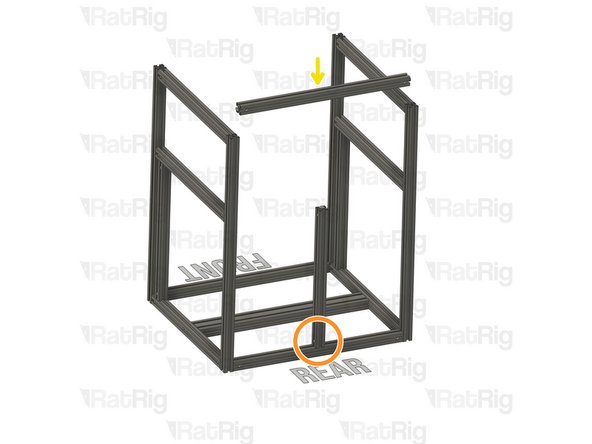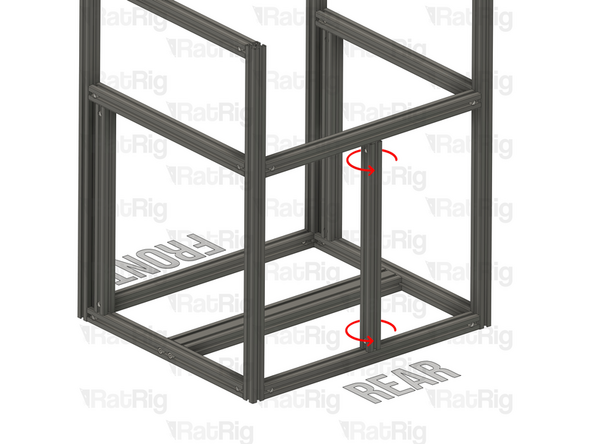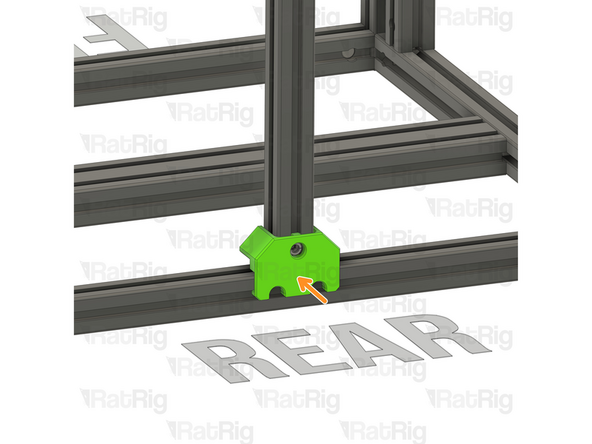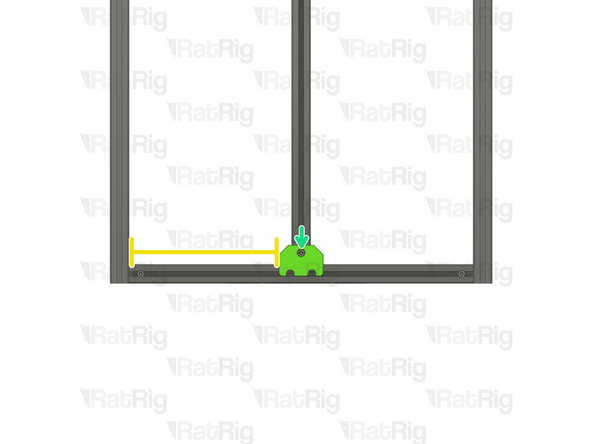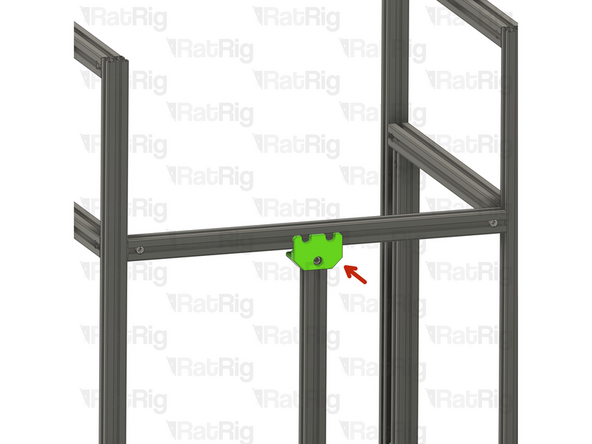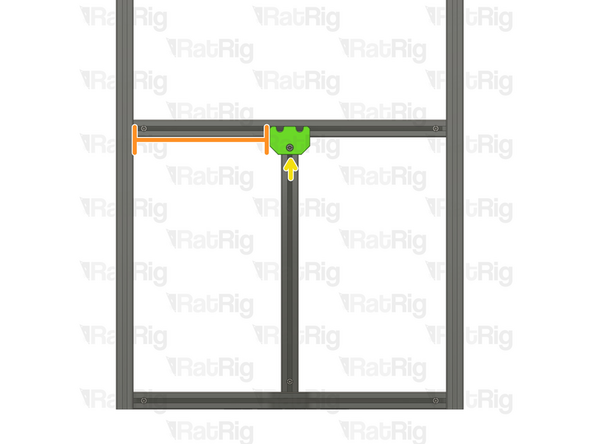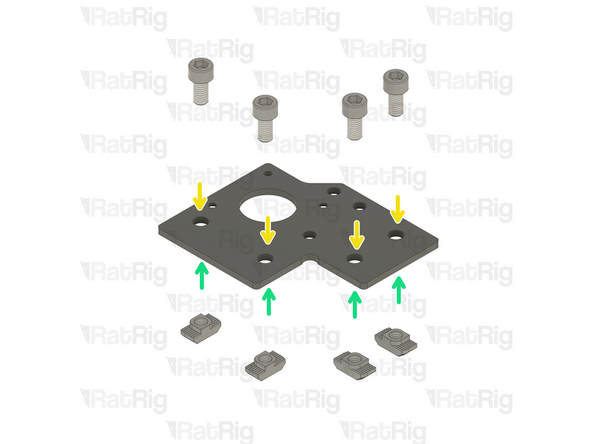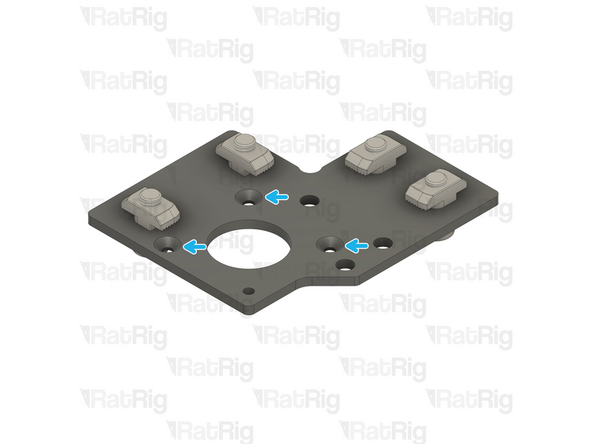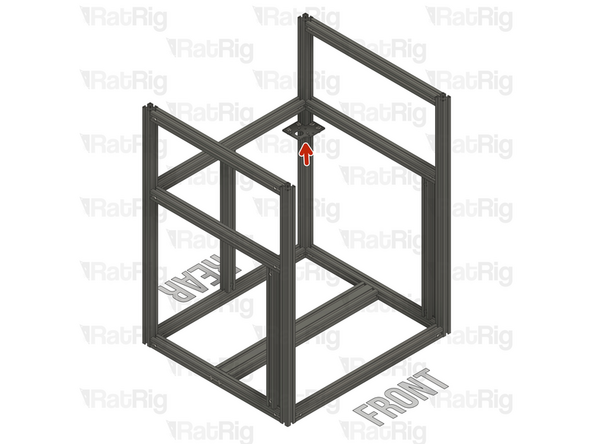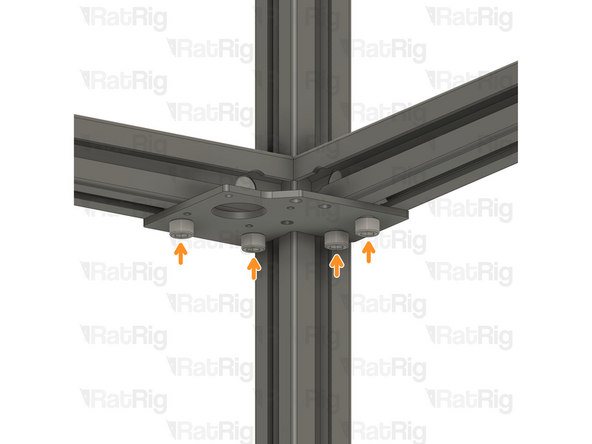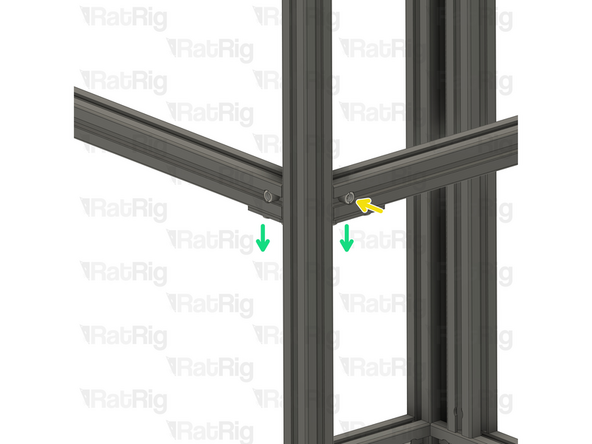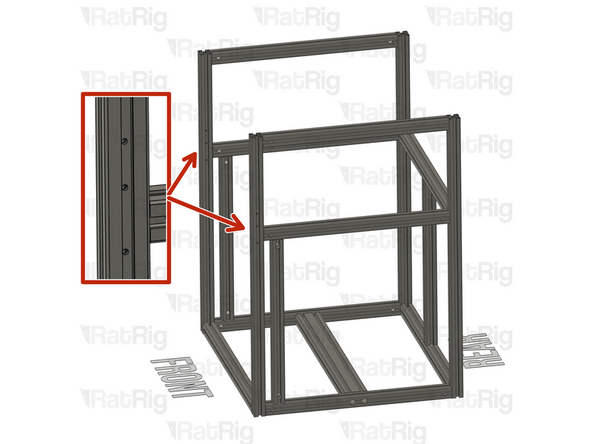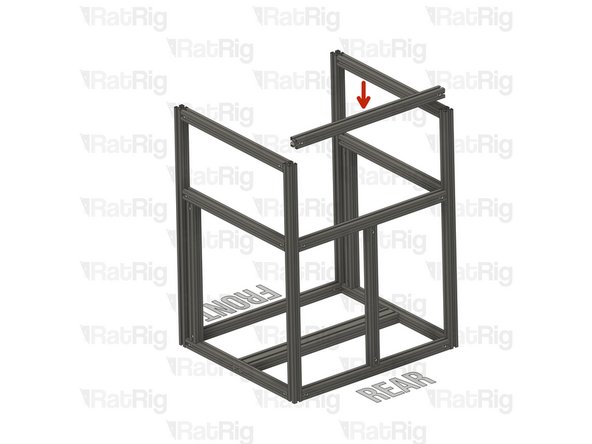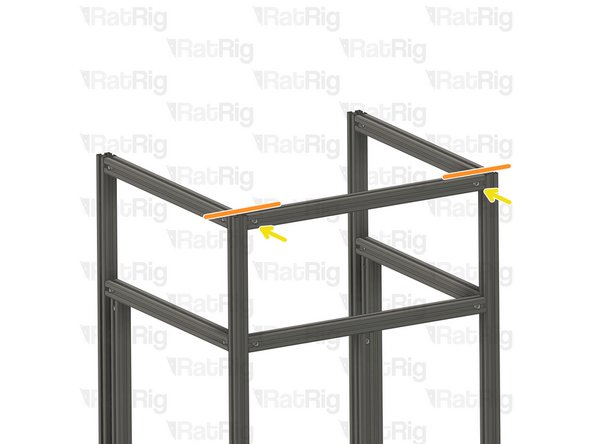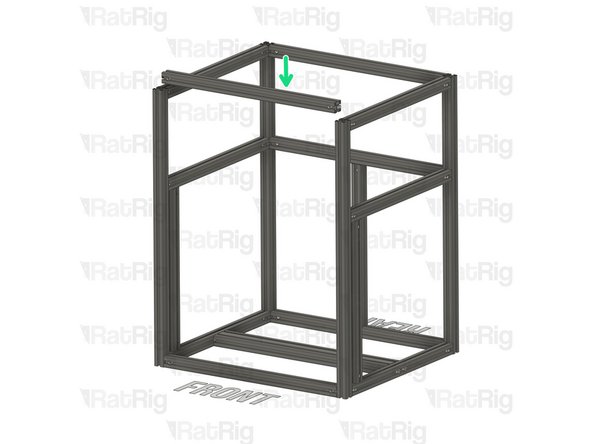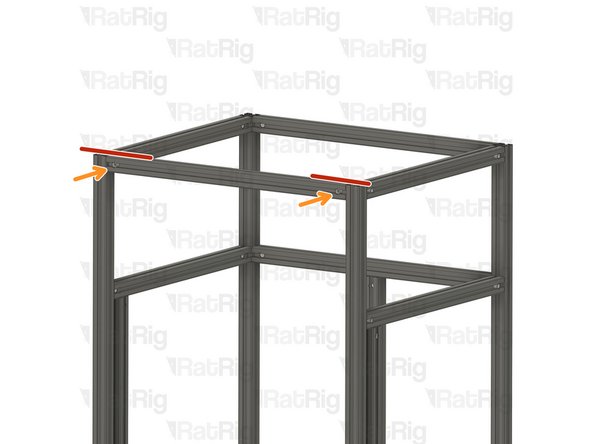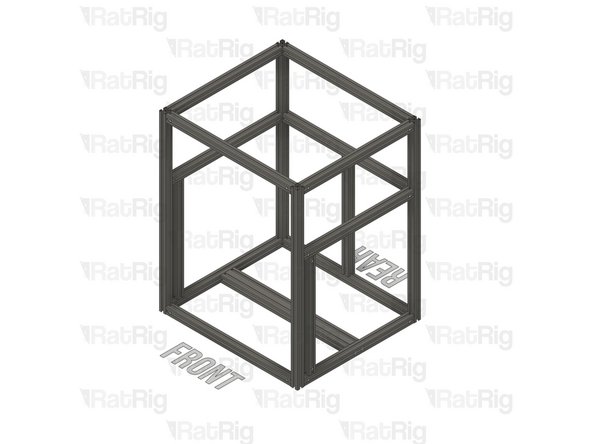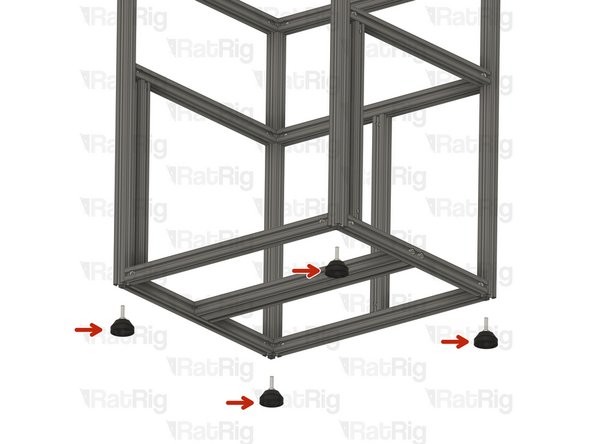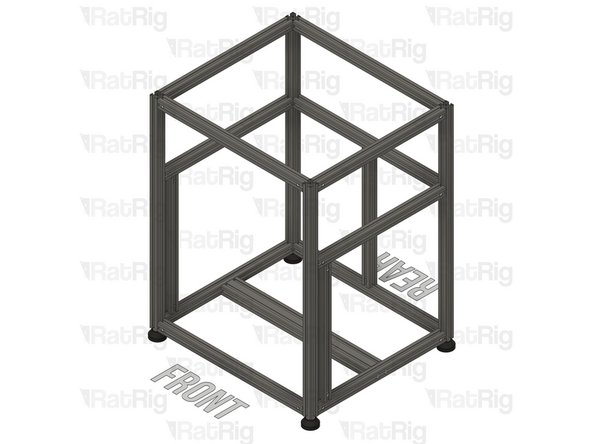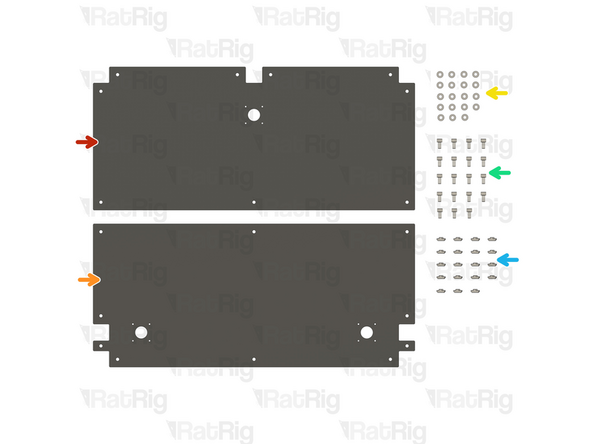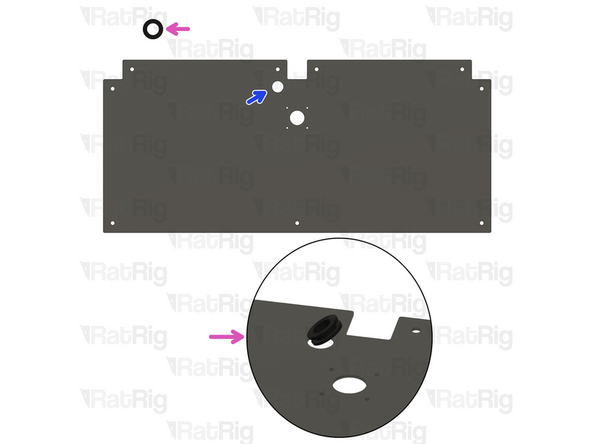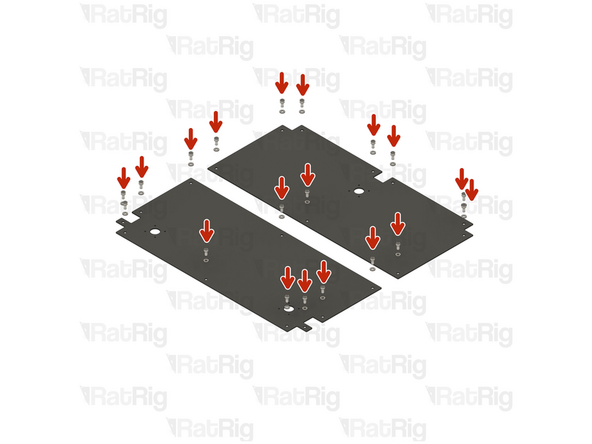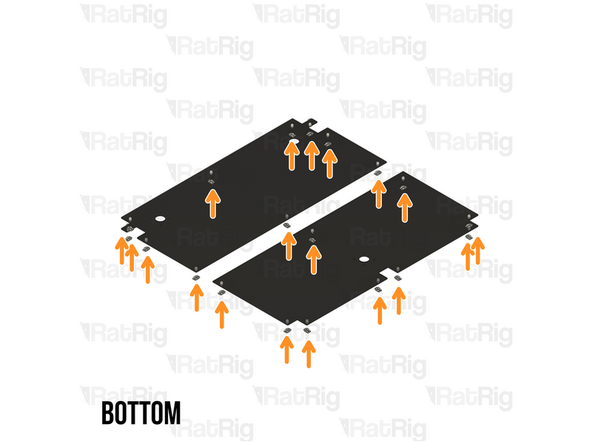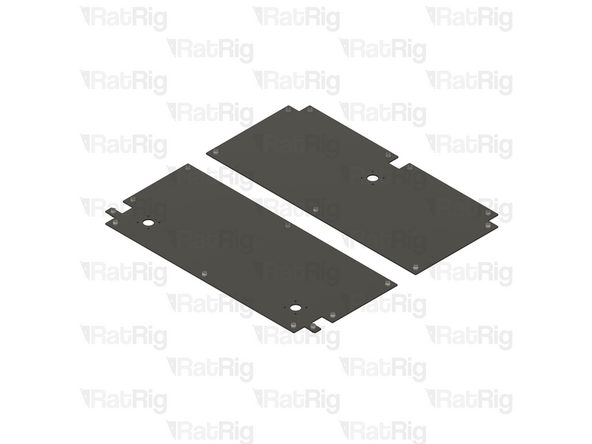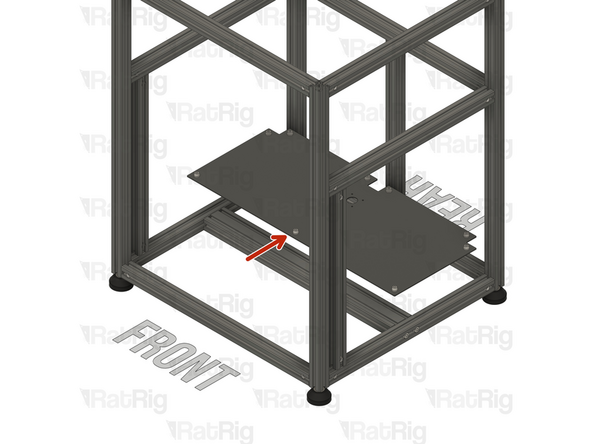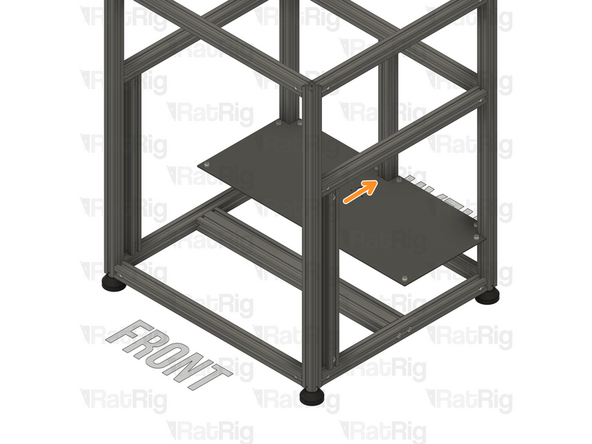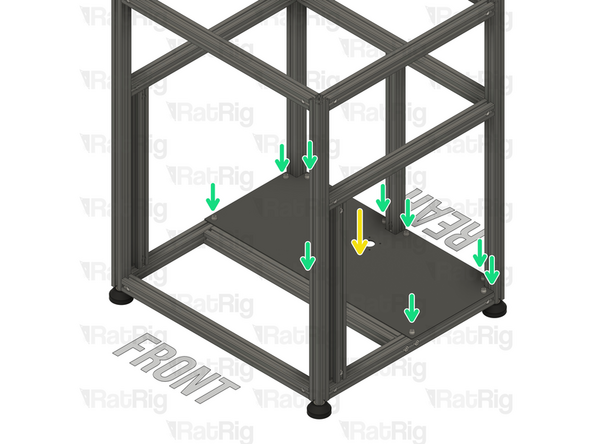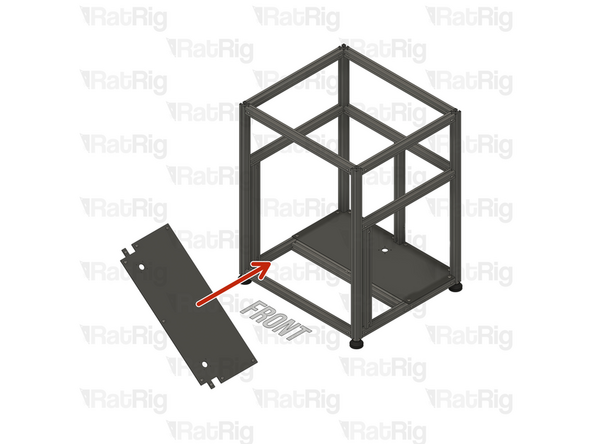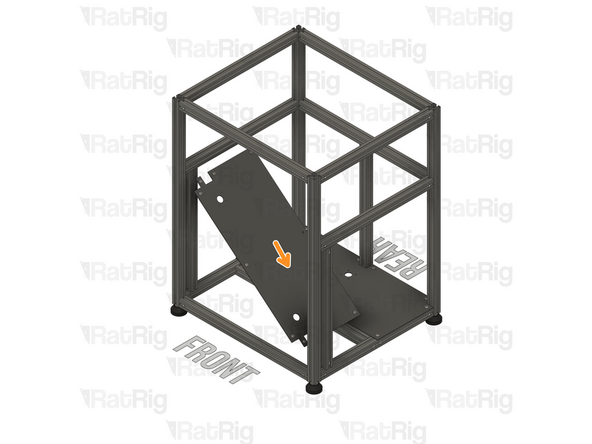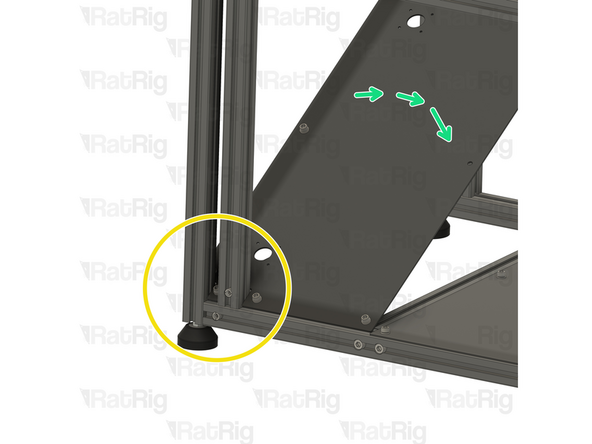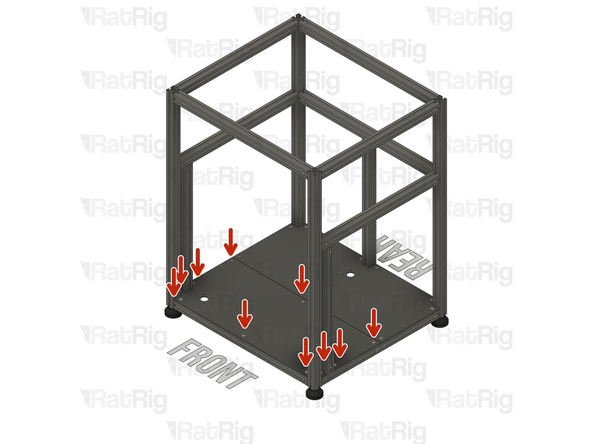Introduction
Please note: All measurements provided in this guide are based upon building a 300x300 V-Core 4.
If you are building a machine of a different size, the following adjustments can be made to the stated extrusion lengths:
- 400x400: Add 100mm
- 500x500: Add 200mm
It is strongly recommended to assemble the frame on a known flat surface (such as a solid table, work surface or similar). Assembling the frame on a carpeted floor, tile floor or other non-flat surface, can cause the finished frame to not be square. This can cause issues with print quality and performance.
-
-
This step is intended to demonstrate how the quick connectors operate, the actual assembly process begins in Step 6
-
T-Nut Pin
-
O-Ring
-
Housing
-
Set Screw
-
-
-
This step is intended to demonstrate how the quick connectors operate, the actual assembly process begins in Step 6
-
The T-Nut pin is responsible for pulling the two extrusions together and ensuring a firm connection- It should be inserted inside the housing as shown.
-
The T-nut pin groove must be below the set-screw.
-
Upon tightening the set screw, its end will exert pressure on the sidewall of the T-Nut pin groove, causing it to close.
-
-
-
This step is intended to demonstrate how the quick connectors operate, the actual assembly process begins in Step 6
-
Before inserting the housing and set screw into the extrusions, make sure the housing hole is free from the set screw.
-
Insert the housing + set screw on the extrusion, with the set screw facing up.
-
The hole on the housing should be aligned with the hole in the extrusion so that the T-Nut pin can be inserted next.
-
Try both sides of the quick connector hole on the extrusion, one side is usually larger than the other.
Consider using a piece of wood in between the insert and the hammer to avoid damaging the metal parts.
Alignment of the insert is quite critical, but the screwdriver slots on the top of them are not at right angles to the hole. The most reliable way I found was to insert the bolt into the housing and use that to get it started into the hole at just the right angle, then remove the bolt and hammer into place. Adjusting afterwards? I found it easier to push them back out and start again.
need a small hamer to insert the housing - hole are too small for most of them (1/10mm?)
this tooks me most of my time to insert them
Try both side of the hole, one side is bit looser than the other
Thank you for your feedback! We've added it to the guide.
Rat Rig -
-
-
-
This step is intended to demonstrate how the quick connectors operate, the actual assembly process begins in Step 6
-
Insert the T-nut pin into the extrusion and quick connector housing
-
The T-nut pin groove must be facing the same side as the set screw, if not, the quick connector won't work.
-
Carefully thread the set screw in, just enough to hold the t-nut pin in the assembly. Do not tighten it, the goal is just to ensure the t-nut pin doesn't fall.
-
When connecting two extrusions, carefully slide the T-nut pin inside the slot of the other extrusion.
Apply a tiny amount of silicone grease to the aluminum holes. Remove the set screw. Position the connector and use a block of wood between your hand and the connector to push the connector into the hole to avoid discomfort to your hand. Rotate the connector, if necessary, with a screwdriver or needle nose pliers as needed to make it align properly in the hole. The connector has to be below flush of the extrusion so I used a C clamp and the shaft of a 3/8" drill bit to gently squeeze the connector below flush. Gently tapping the T-nut head with the block of wood will cause it to climb the ramp built into the connector for final connector positioning. Screw in the screw just tight enough to grab the T-nut so it won't fall out. Eventual apply silicone grease to the O ring on the T-nut to allow it to smoothly enter the extrusion at final assembly.
I ran into two interference issues: first, some of my supplied quick connector housings had rough cross-drilling and needed some manual deburring to clear them enough for the pins to actually slide in.
Secondly, maybe 1/3 of my pins were slightly to extremely difficult to get the o-ring into the extrusion end. Most I managed by manually stuffing the entire perimeter of the o-ring.
-
-
-
This step is intended to demonstrate how the quick connectors operate, the actual assembly process begins in Step 6
-
When sliding the extrusion to the right place, be careful, and take it slowly so as to not damage the extrusion coating.
-
Once the extrusions are in the right place, you can firmly tighten the set screw.
-
The T-nut pin will be pulled inside and firmly attached the extrusions.
-
Always verify the strength of the connection between the extrusions. If the connection is not strong, loosen the set screw, ensure that the T-nut pin groove is positioned below the set screw, and reconnect the extrusions.
Consider at this point if you want to use Loctite for the frame. I have used 243 for previous Voron builds and did so again.
Once a full section (side, base, etc. below) is assembled to your satisfaction and well aligned, it doesn't take long to go back and run out one set screw at a time and apply Loctite, without losing square.
-
-
-
Prepare 28x Quick connectors
-
Prepare the following extrusions with quick connectors on both sides:
-
3x T-Slot 3030 Milled extrusion- 440mm
-
4x T-Slot 3030 Milled extrusion - 475mm
-
2x T-Slot 3030 Milled - 475mm with 2xM8 holes
-
Ensure the quick connector set screws are facing the same side as the M8 screw head holes.
-
5x T-Slot 3030 Milled extrusion - 540mm
-
If you are building a machine of a different size, add 100mm to all extrusions for the V-Core 4 400 and 200mm for the V-Core 4 500
-
-
-
If you are building a different size V-Core 4, add the following lengths to the extrusions:
-
V-Core 4 400 - add 100mm to all extrusions
-
V-Core 4 500 - add 200mm to all extrusions
-
-
-
Have the following extrusions and Frame jig near you, to proceed with the frame assembly:
-
3x T-Slot 3030 Milled extrusion- 440mm with 2 quick connectors
-
4x T-Slot 3030 Milled extrusion - 475mm with 2 quick connectors
-
2x T-Slot 3030 Milled extrusion - 475mm with 2 quick connectors and 2xM8 holes
-
5x T-Slot 3030 Milled extrusion - 540 with 2 quick connectors
-
2x T-Slot 3030 Milled extrusion - 750mm
-
2x T-Slot 3030 Milled extrusion - 750mm with 3xM4 holes
-
1x T-Slot 3060 extrusion - 540mm
To prevent frustration with misaligned quick-connectors, I used this trick to align them properly in advance.
The housings fit only on one side of the extrusion, not both. On the correct side, they'll just drop in a bit without any force, just by gravity.
- Drop in the housing into the correct hole, just let it sit by gravity, do not apply any force. You can freely rotate it to align the whole with the length of the extrusion.
- Align the T-Nut pin with the hole to make sure the housing is oriented correctly.
- Remove the T-Nut pin
- Press in the housing by hand, this is likely quite hard to get in.
- I then put in a hex-wrench into the set-screw of the housing and put the whole thing into my table-vice.
- Check that the housing hole is still aligned in the correct orientation. If it's not, fix it now, it will be much harder later.
- insert the T-nut pin into the center hole of the extrusion until it hits the housing
- now slowly close down on the vice, slowly pushing in the housing. At the same time wiggle the pin.
- Keep closing in on the vice slowly until the pin just slides in without force.
Now your housing is properly aligned, and at the correct height
- Make sure to hold on to the extrusion while opening up the vice again. (to prevent the extrusion getting damaged by accidentally dropping down.)
It's easy to miss that the single 3060 extrusion and the four longest extrusions will not get any quick-connectors.
The single printed part is in the bag labelled “Machine kit printed parts bundle SKU: HW3696MK VC4.0-PPB_04-00”. (SKU is for the 500mm kit, it may be different for other sizes.)
MacLemon -
-
-
-
T-Slot 3030 Milled extrusion - 2xM8 - 475mm
-
Ensure the M8 holes are oriented in the correct direction
-
T-Slot 3030 Milled extrusion - 750mm
-
T-Slot 3030 Milled - 750mm with 3xM4 holes
-
Assemble this extrusion on the front of the frame, with the 3xM4 holes oriented as shown. Be aware of the extrusion orientation, the small spacing between the M4 holes must be upwards.
-
Align and insert the T-nut pin on the extrusion slot.
-
When sliding the extrusion to the right place, be careful, and take it slowly to not damage the extrusion coating.
-
Don't use ball-end hex-tools! Those can easily damage the quick connectors.
-
-
-
Lay the assembly on a flat surface, this is crucial to ensure a square frame
-
Good flat surfaces: Poured concrete, glass, stone countertop
-
Bad flat surfaces: Carpeted floor, tile floor, concrete surface
-
Align the extrusions - make sure they are flush
-
Tighten the quick connectors to secure the extrusions together.
-
Always verify the strength of the connection between the extrusions. If the connection is not strong, loosen the set screw, ensure that the T-nut pin groove is positioned below the set screw, and reconnect the extrusions.
-
Build Tip: You can use a spare 3030 extrusion or the Engineer Square to help align the assembly
-
Repeat the previous steps and tighten the marked quick connector.
-
-
-
T-Slot 3030 Milled extrusion - 440mm
-
Align the T-nut pin with the bottom extrusion slot
-
Insert the T-nut pin in the bottom extrusion slot.
-
T-Slot 3030 Milled extrusion - 475mm
-
Insert the extrusion on the assembly, making sure the T-nut pins are aligned with the side extrusion slots.
-
When sliding the extrusion to the right place, be careful, and take it slowly so as to not damage the extrusion coating.
Need to show that the holes on the front extrusions should be on the same side as the fasteners, otherwise you get to step 30 and have to disassemble the frame.
-
-
-
Align the T-Slot 3030 Milled extrusion - 475mm to have the T-nut pin inside the slot.
-
Carefully rotate the T-Slot 3030 Milled extrusion - 440mm 90º so the quick connectors face the side shown in the picture.
-
When sliding the extrusion to the right place, be careful, and take it slowly so as to not damage the extrusion coating.
-
Insert the frame jig on the assembly, as shown.
Having two pieces of the alignment jig would make it much easier to align all the parts. Likely also more precise. (Would be great if the printed-parts set included two.)
If you have access to another printer and would like to print a second one: This should be the part to print from the BOM. V-Core-4.0/PP000279-vc4_frame_jig_V01_20...
-
-
-
Make sure the frame jig is inserted all the way and completely flush with the extrusion
-
Ensure the frame jig is inside the bottom extrusion slot.
-
Lay the assembly on a flat surface
-
Push the frame jig to the right, eliminating any play between the frame jig and the extrusions
-
Tighten the quick connector to secure the extrusions together.
-
Always verify the strength of the connection between the extrusions. If the connection is not strong, loosen the set screw, ensure that the T-nut pin groove is positioned below the set screw, and reconnect the extrusions.
-
-
-
Insert the frame jig on the assembly, as shown.
-
Make sure the frame jig is inserted all the way and completely flush with the extrusion
-
Ensure the frame jig is inside the extrusion slot.
-
Push the frame jig to the right, eliminating any play between the frame jig and the extrusions
-
Tighten the quick connectors to secure the extrusions together.
-
Always verify the strength of the connection between the extrusions. If the connection is not strong, loosen the set screw, ensure that the T-nut pin groove is positioned below the set screw, and reconnect the extrusions.
-
Ensure the distance between the extrusion and the top of the assembly is 250mm
-
Tighten the quick connectors to secure the extrusions together.
To assist with triple checking for squareness, you can use a measuring tape to measure the gap on the top and bottom of the side extrusion. For example, even though I was confident in it being square with my carpentry triangles, I measured the gap and came up with 3/4" on both the top and bottom.
When positioning the horizontal above the short vertical section, use another short vertical as a temporary spacer on the other end to guarantee the horizontal is perpendicular to the major frame. Once everything is tightened, remove the spacer.
Here when it's mentioned 250, you don't need to add 100 or 200 compared to extrusions
-
-
-
T-Slot 3030 Milled extrusion - 475mm
-
Insert the extrusion on the assembly, making sure the T-nut pins are aligned with the side extrusion slots.
-
Align the extrusions - make sure they are flush
-
Check Step 10 on how to correctly align the extrusions
-
Tighten the quick connectors to secure the extrusions together.
-
Always verify the strength of the connection between the extrusions. If the connection is not strong, loosen the set screw, ensure that the T-nut pin groove is positioned below the set screw, and reconnect the extrusions.
-
-
-
These next steps will help you put together the right side frame part. The frames are like reflections of each other. Even though the next steps are brief, you can find more detailed info in Steps 9-15.
-
Follow the designated steps carefully to ensure the new assembly is mirrored
-
-
-
T-Slot 3030 Milled extrusion - 2xM8 - 475mm
-
Ensure the M8 holes are oriented in the correct direction
-
T-Slot 3030 Milled - 750mm with 3xM4 holes
-
T-Slot 3030 Milled - 750mm
-
Assemble this extrusion on the front of the frame, with the 3xM3 holes facing the sides. Be aware of the extrusion orientation, the small spacing between the M3 holes must be upwards.
-
Align and insert the T-nut pin on the extrusion slot.
-
Lay the assembly on a flat surface, this is crucial to ensure a square frame
-
Align and tighten the marked extrusions and quick connectors - Refer to Step 10
-
-
-
T-Slot 3030 Milled extrusion - 440mm
-
Align and insert the T-nut pin in the bottom extrusion slot.
-
T-Slot 3030 Milled extrusion - 475mm
-
Carefully rotate the T-Slot 3030 Milled extrusion - 440mm 90º so the quick connectors face the side shown in the picture.
-
When sliding the extrusion to the right place, be careful, and take it slowly so as to not damage the extrusion coating.
-
-
-
Lay the assembly on a flat surface
-
Insert the frame jig on the assembly, make sure the frame jig is inserted all the way and completely flush with the extrusion
-
Push the frame jig to the left, eliminating any play between the frame jig and the extrusions
-
Tighten the quick connector to secure the extrusions together.
-
Always verify the strength of the connection between the extrusions. If the connection is not strong, loosen the set screw, ensure that the T-nut pin groove is positioned below the set screw, and reconnect the extrusions.
-
Insert the frame jig on the assembly, make sure the frame jig is inserted all the way and completely flush with the extrusion
-
-
-
Ensure the frame jig is inside the extrusion slot.
-
Push the frame jig to the left, eliminating any play between the frame jig and the extrusions
-
Tighten the quick connector to secure the extrusions together.
-
Always verify the strength of the connection between the extrusions. If the connection is not strong, loosen the set screw, ensure that the T-nut pin groove is positioned below the set screw, and reconnect the extrusions.
-
Ensure the distance between the extrusion and the top of the assembly is 250mm
-
Tighten the quick connectors to secure the extrusions together.
-
-
-
T-Slot 3030 Milled extrusion - 475mm
-
Insert the extrusion on the assembly, making sure the T-nut pins are aligned with the side extrusion slots.
-
Align the extrusions - make sure they are flush
-
Check Step 10 on how to correctly align the extrusions
-
Tighten the quick connectors to secure the extrusions together.
-
Always verify the strength of the connection between the extrusions. If the connection is not strong, loosen the set screw, ensure that the T-nut pin groove is positioned below the set screw, and reconnect the extrusions.
-
-
-
Left Side frame sub-assembly
-
T-Slot 3060 extrusion - 540mm
-
Align the extrusion with the two holes on the side frame sub-assembly bottom extrusion
-
2x M8x40 Cap Head screw
-
Insert them into the sub frame assembly and tighten them to the T-Slot 3060 extrusion - 540mm
-
2x T-Slot 3030 Milled extrusion - 540mm
-
Insert the extrusion on the assembly, making sure the T-nut pins are aligned with the side extrusion slots.
-
When sliding the extrusion to the right place, be careful, and take it slowly so as to not damage the extrusion coating.
-
-
-
Place the assembly on a flat surface, as to ensure all extrusions are correctly aligned.
-
Tighten the quick connectors to secure the extrusions together.
-
Always verify the strength of the connection between the extrusions. If the connection is not strong, loosen the set screw, ensure that the T-nut pin groove is positioned below the set screw, and reconnect the extrusions.
-
-
-
Right Side frame sub-assembly
-
Insert the extrusion on the assembly, making sure the T-nut pins are aligned with the side extrusion slots.
-
When sliding the extrusion to the right place, be careful, and take it slowly so as to not damage the extrusion coating.
-
Align the extrusion with the two holes on the side frame sub-assembly bottom extrusion
-
Insert 2x M8x40 Cap Head screw into the sub frame assembly and tighten to the T-Slot 3060 extrusion - 540mm
-
Place the assembly on a flat surface, as to ensure all extrusions are correctly aligned.
-
Tighten the quick connectors to secure the extrusions together.
-
Always verify the strength of the connection between the extrusions. If the connection is not strong, loosen the set screw, ensure that the T-nut pin groove is positioned below the set screw, and reconnect the extrusions.
-
-
-
T-Slot 3030 Milled extrusion - 440mm
-
Align the T-nut pin with the bottom extrusion slot
-
Insert the T-nut pin in the bottom extrusion slot.
-
T-Slot 3030 Milled extrusion - 540mm
-
Insert the extrusion on the assembly, making sure the T-nut pins are aligned with the side extrusion slots.
-
When sliding the extrusion to the right place, be careful, and take it slowly so as to not damage the extrusion coating.
-
-
-
Carefully rotate the T-Slot 3030 Milled extrusion - 440mm 90º so the quick connectors face the side shown in the picture.
-
Insert the frame jig on the assembly, make sure the frame jig is inserted all the way and completely flush with the extrusion
-
Ensure the distance between the frame jig side wall and the frame extrusion is 235mm
-
It should be 285mm for the V-Core 4 400 and 335mm for the V-Core 4 500
-
Tighten the quick connector to secure the extrusions together.
-
Always verify the strength of the connection between the extrusions. If the connection is not strong, loosen the set screw, ensure that the T-nut pin groove is positioned below the set screw, and reconnect the extrusions.
For the VC4-400, a 12" steel rule fits exactly in the space between the frame and the extrusions (305mm).
-
-
-
Insert the frame jig on the assembly, make sure the frame jig is inserted all the way and completely flush with the extrusion
-
Ensure the distance between the frame jig side wall and the frame extrusion is 235mm
-
Add 50mm for the V-Core 4 400 and 100mm for the V-Core 4 500
-
Tighten the quick connector to secure the extrusions together.
-
Always verify the strength of the connection between the extrusions. If the connection is not strong, loosen the set screw, ensure that the T-nut pin groove is positioned below the set screw, and reconnect the extrusions.
-
-
-
In this step, you will prepare two stepper motor plates with screws and T-nuts, although they will only be used to align the frame.
-
Rat Rig V-Core 4.0 - Motor Plate - Lower Left v1.0
-
Rat Rig V-Core 4.0 - Motor Plate - Lower Right v1.0
-
8x M6x12 Cap Head Screw
-
8x 3030 Drop In T-Nut M6
-
Loosely thread the 3030 T-Nuts onto the M6x12 screws. Do not tighten them at this point.
-
Please notice: The t-nuts should be on the same side as the countersink holes.
-
-
-
Install the Rat Rig V-Core 4.0 - Motor Plate - Lower Right v1.0 Assembly to the frame as shown
-
Tighten the M6x12 Cap Head Screws to secure the plate and guarantee the extrusions are perfectly aligned.
-
Tighten the quick connector to secure the extrusions together.
-
Always verify the strength of the connection between the extrusions. If the connection is not strong, loosen the set screw, ensure that the T-nut pin groove is positioned below the set screw, and reconnect the extrusions.
-
Remove the Rat Rig V-Core 4.0 - Motor Plate - Lower Right v1.0 Assembly and set it aside, it will be used later in the guide.
-
Repeat the Steps above for the other end of the extrusion, using the Rat Rig V-Core 4.0 - Motor Plate - Lower Left v1.0 Assembly
-
-
-
Make sure the front side extrusions have the 3xM3 holes facing the sides. Be aware of the extrusion orientation, the small spacing between the M3 holes must be upwards.
-
-
-
T-Slot 3030 Milled extrusion - 540mm
-
Insert the extrusion on the assembly, making sure the T-nut pins are aligned with the side extrusion slots.
-
Ensure the two extrusions are perfectly aligned
-
Refer to Step 10 on how to accurately align the extrusions.
-
Tighten the quick connectors to secure the extrusions together.
-
Always verify the strength of the connection between the extrusions. If the connection is not strong, loosen the set screw, ensure that the T-nut pin groove is positioned below the set screw, and reconnect the extrusions.
-
T-Slot 3030 Milled extrusion - 540mm
-
Insert the extrusion on the assembly, making sure the T-nut pins are aligned with the side extrusion slots.
-
-
-
Ensure the two extrusions are perfectly aligned
-
Refer to Step 10 on how to accurately align the extrusions.
-
Tighten the quick connectors to secure the extrusions together.
-
Always verify the strength of the connection between the extrusions. If the connection is not strong, loosen the set screw, ensure that the T-nut pin groove is positioned below the set screw, and reconnect the extrusions.
-
-
-
4 x V-Core 4 rubber feet
-
Tighten the four V-Core 4 rubber feet to the frame assembly
-
-
-
1x Rear base plate
-
The rear plate has been recently updated. If you purchased your kit recently, your rear plate may feature a new hole for the Z stepper motor cable management. Refer to the second picture for more details.
-
1x Front base plate
-
19x M6 Washer
-
19x M6x12 Cap Head Screws
-
19x 3030 M6 Drop in T-Nut
-
Updated rear base plate with Z cable passthrough.
-
Rubber grommet. Insert the grommet in the designated hole.
26 holes for the 500 size not 19
I can confirm this, I got 26 screw holes.
What thickness should base plate be and what material should it be made of?
New front base plate has 20 6mm holes, not 19
-
-
-
Inset a M6x12 Cap Head Screw + M6 washer on every 6mm hole on the base plates.
-
Loosely thread the 3030 T-Nuts onto the M6x12 screws. Do not tighten them at this point.
If you have two holes in each corner on the front, put there also a T-Nut and screw in. Then you are able to mount the cast angle in 11. Accessories, Step 28 with all four bolts.
Pictures are not updated for Z cable passthrough
adding the 3 Z motors with cusion in this step would be far easier, in the next step you have to lift up the already assembled frame and hold them in place while trying to screw them to the cusion whil supporting the weight of the frame
-
-
-
Rear base plate assembly
-
Carefully place it inside the frame. The Z cable passthrough should be on the left side when facing the front of the printer.
-
Ensure the base plate assembly is pushed all the way to the back and aligned with the rear extrusions.
-
When sliding the base plate assembly to the right place, be careful, and take it slowly so as to not damage the extrusion coating.
-
Place the base plate assembly on the bottom of the frame
-
Make sure every 3030 Drop In T-nut aligns with the extrusion slots
-
Tighten the M6x12 Cap Head Screws to secure the base plate assembly to the frame.
The general consensus on the discord is the foam strips should be installed between the base plates and frame. RATRIG you need to fix the guide! Look at the solid model to see where to place the strips. In general it goes on the inboard upper side of all the base extrusions. Obviously do not place it between the vertical extrusions and base extrusions, kind of goes without saying.
V4 400 has a bag of "Foam EVA 3M 1x8mm custom" SKU: HW2943GC which looks perfect for isolating the base plates from the frame. No mention of its use anwhere else in this build doc, so I'm assuming this is the intent for the material.
Its for enclosure and according to the step file, some of it goes between the base plate and extrusions in H shaped manner (inner sides of 3030 extrusions and 3 strips on the 3060 one)
Kuroi -
The CAD model has foam seals between the frame and the base plates. This is not mentioned here, nor is it mentioned in the Enclosure section
Based on Electronics section 12. Electronics the grommet on the rear panel should be on the LEFT. It's not clear from this diagram.
Every picture that includes the new grommeted hole shows it on the left. Look at the supplemental image tied to the notification of the change in newer machines.
I am working on a hybrid 500, but I don't think that matters
Steve -
Based on the hole that I have the z-axis motors going through (The one closest to the stepper motor drivers on a VCore-4 400) I have the grommet on the rear pannel being on the Machine's Right. Where did you route your stepper motors through?
Pictures are not updated for Z cable passthrough
-
-
-
Insert the front base plate inside the frame assembly, at an angle so it can be rotated into place.
-
When sliding the base plate assembly to the right place, be careful, and take it slowly so as to not damage the extrusion coating.
-
Carefully rotate the front base panel towards the side of the frame, as shown.
-
Align the base panel with the extrusions
-
Rotate the front base plate assembly into position.
-
-
-
Tighten the M6x12 Cap Head Screws to secure the base plate assembly to the frame.
I personally put 2 holes along the front edge of the forward plate on my 500 as the one center hole was missing
I'de also like to second the thought above about adding the corner brackets at this point, no reason to take those screws out to replace them later.
Lastly, I forced the 2 plates as far from each other as I could, again, to prevent rattle
I also covered every part of the base frame that would come in contact with the place with Tesa branded cloth electrical tape. This was done to help prevent rattles that might normally develop over time.
-
Cancel: I did not complete this guide.
41 other people completed this guide.
3 Comments
My base plates (500mm version) have extra holes should these be used also making it 25 m6 hardware sets (m6x12 screw, washer, tnut)?
Some of the T-nuts I received arent beveled enough to be useful. picture of t-nuts in question. Any way I can resolve this quickly?
My 400mm version has no hole in the front center of the front baseplate. Is that a design revision, or do I need to grab a drill?
Also, the back plate with the new version (with grommet- it's labeled "Rubber Grommet 18x14x3" on the bag) does the hole belong on the left side when facing in from the front?
Cheers!







